
Clay Cartland, Gaby Tortoledo and Sofia Porcel, in Which Way to the Stage at Island City Stage. Photo by Matthew Tippins
By Aaron Krause
You’ve got to admire and respect actors: For them, gigs can be few and far between. And that means they must often work odd jobs to pay the bills, while continuing to practice their craft.
When actors are cast in shows, they toil for long hours for often low pay. In fact, many performers will tell you that they are not in it for the money. Rather, their greatest joy comes from entertaining audiences. By doing so, they allow people to escape the cruel real world for a couple of hours.
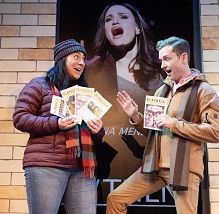
Sofia Porcel and Clay Cartland in Which Way to the Stage at Island City Stage. Photo by Matthew Tippins
Certainly, Ana Nogueira’s entertaining, thought-provoking, and meaty comedy, Which Way to the Stage, is a love letter and tribute to actors and musical theater. But the playwright does not pretend that everything in live theater and performers’ lives is sunny.
Kudos to Island City Stage (ICS) in Wilton Manors for mounting an energetic and believable professional production of Nogueira’s relevant and pleasing play with plenty of laughs. It runs through Feb. 11 in ICS’s intimate black box theater space.
A quartet of talented performers delivers convincing performances under Michael Leeds’ astute direction.
Chances are you will recognize most cast members from their work in South Florida. Specifically, Matthew Buffalo, Clay Cartland, Sofia Porcel, and Gaby Tortoledo comprise the cast. They deliver nuanced and multifaceted performances that seem spontaneous.
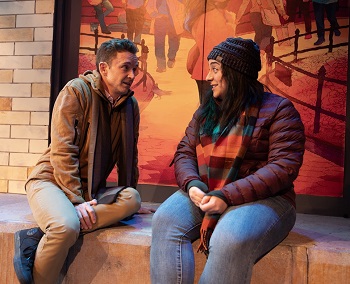
Matthew Buffalo and Sofia Porcel in Which Way to the Stage at Island City Stage. Photo by Matthew Tippins
Which Way to the Stage, which takes place in 2015, premiered in New York in 2022. The piece follows fictional actors Judy (Porcel) and Jeff (Buffalo). They are huge fans of real-life Broadway star Idina Menzel, who performed leading roles in such shows as Rent, Wicked, and If/Then.
Besties Judy and Jeff frequently hang out at the stage door of the Broadway production of If/Then. After Judy and Jeff first experienced If/Then, they repeatedly returned to Richard Rodgers’ stage door to obtain Menzel’s autograph.
However, she never came out.
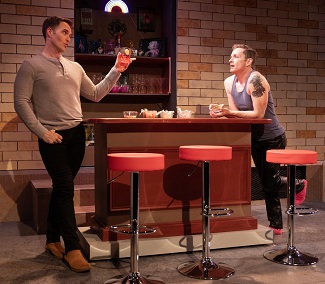
Matthew Buffalo and Clay Cartland in Which Way to the Stage at Island City Stage. Photo by Matthew Tippins
Not to be deterred, the couple keeps waiting for that elusive autograph. Will Menzel ever emerge, the characters must wonder. Which Way to the Stage examines themes such as friendship, ambition, dreams, gender and sexual identity.
The play asks questions such as who decides what is “feminine” and “masculine?” Also, when, if ever, is drag misogynistic? And what is the difference between keeping one’s sexuality private and being in the closet? Also, in live theater, is there a dearth of leading characters who are gay? Jeff, a homosexual who operates and performs in a drag show, seems to think so.
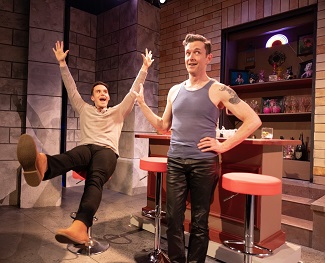
Matthew Buffalo and Clay Cartland in Which Way to the Stage at Island City Stage. Photo by Matthew Tippins
“How many gay characters are there in musicals?” he asks Mark, a musical theater performer Judy meets at an audition. “Gay leads. Good, meaty roles.”
The playwright uses unapologetically direct language to allow the characters to express their viewpoint.
“Look, as a gay – wait, I should say – as an out gay man. An out and proud, my-dick-is-somewhere-on-the-Internet gay man, I’m gonna be playing the sort of faggoty straight leading man – the Jimmy’s in Thoroughly Modern Millie, Elder Price in (The Book of) Morman, Princeton in Avenue Q…Best case scenario, I get to play Billy Flynn.”
Speaking of Flynn, Nogueira sometimes displays the annoying habit of not identifying terms and people with whom some audiences may be unfamiliar. For instance, the playwright fails to identify Flynn as an established lawyer in the musical Chicago who has never lost a woman’s case, and is a master of media manipulation.
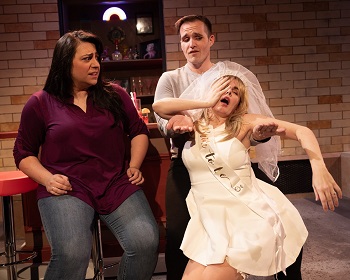
Sofia Porcel, Clay Cartland, and Gaby Tortoledo in Which Way to the Stage at Island City Stage. Photo by Matthew Tippins
Also, if your average audience member does not know what an EPA is, that person is out of luck. In the play, it is not the Environmental Protection Agency. Rather, Equity Principal Auditions (EPAs) are auditions that are open to Actors Equity Association members, providing the opportunity for an Equity (union) actor to be seen by a regional theater, Off-Broadway, or Broadway production. Equity Membership Candidates (EMC) may also participate if time allows. Meanwhile, non-union actors may or may not be seen, depending on time or management.
While it is not essential to the action, you would think that at some point during the play, Nogueira would at least briefly describe If/Then or use it in some creative manner.
If/Then simultaneously follows one woman’s two possible life paths. More specifically, Elizabeth, a city planner, moves back to New York to restart her life in the city that never sleeps. When her carefully designed plans collide with the whims of fate, Elizabeth’s life splits into two parallel paths depicted in the evening.
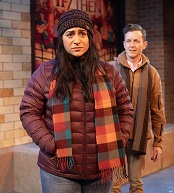
Sofia Porcel and Matthew Buffalo in Which Way to the Stage at Island City Stage. Photo by Matthew Tippins
In addition to If/Then, Which Way to the Stage mentions several other shows with which audiences may be more familiar. They include the mega-popular Hamilton: An American Musical.
Without a doubt, Which Way to the Stage includes moments that will delight live theater aficionados. One such moment comes after Mark notes that he likes to avoid waiting in lines.
“I guess if I don’t get over that I won’t be able to see that show – that Hamilton thing. You guys know about that (show)?”
In addition, those into live theater will likely laugh at exchanges such as the following:
Mark: Chicago is a good show, I thought.
Judy: Chicago is a great show. But it’s a terrible revival.
Mark: What, didn’t it win, like, 6 Tonys?
Jeff/Judy: As if the Tonys mean anything.
While the play celebrates live theater and performers, it provides balance. Specifically, it also touches on areas in which the art form may need to improve, such as the supposed lack of quality roles for certain segments of the population. Also, in the play, a character notes that a director sexually harassed her when they worked together. In reality, sexual harassment has been a problem in the world of live theater for a while.
Nogueira does not provide answers to issues that she explores. Rather, she leaves it up to audience members to discuss and reflect on what they’ve seen. Indeed, live theater is at its best when it provokes discussion and reflection rather than offering answers.
Live theater is also great when actors and other artists triumph in a production. That is the case with this mounting of Which Way to the Stage.
For instance, Buffalo imbues Jeff with convincing passion and an unapologetic air about his convictions and identity. Also, Buffalo demonstrates deft comic timing and strong chemistry with Porcel as Judy.
With Judy, Porcel delivers a performance blessed with depth, conviction, and believability. The performer excels during lighthearted moments, but also shines as Judy intensely, yet naturally conveys her emotional pain and frustration. Overall, Porcel’s Judy is intelligent, funny, and someone we wouldn’t mind getting to know better.
As Mark, Cartland also presents a likable character. The actor imbues his character with sincerity, charm, enthusiasm, complacency, and unpredictability.
Meanwhile, Tortoledo is a hoot as a bachelorette, and genuine as an actress at an audition.
Under Leeds’ inspired direction, comic moments and more dramatic instances receive the emphasis they deserve. Also, Leeds paces the production just right and stages the proceedings smartly.
Nogueira’s dialogue is sometimes fast-paced, while at other times, pauses force the actors to communicate nonverbally. The cast excels throughout. Under Leeds’ guidance, the pauses have impact and the cast handles the fast-paced dialogue with flair.
Ardean Landhuis lighting is appropriately realistic while his set is spacious and specific. And W. Emil White’s costumes befit the characters who wear them.
Which Way to the Stage isn’t a perfect piece. For instance, the beginning and ending feel awkward. More specifically, it’s hard to understand what the actors are talking about at the beginning of the play. And the ending is too abrupt. Also, as mentioned above, the lack of explanations in the play can leave audience members figuratively in the dark. But often, the play is irresistible, especially if you are a musical theater fan.
But you don’t have to love musicals or live theater to appreciate Which Way to the Stage. The play, for instance, examines what happens when dreams fall just out of reach.
The multi-award-winning ICS kicked off this theater season with an exemplary production of the classic Love! Valour! Compassion! Now, for the season’s second offering, ICS is presenting the lesser known yet enjoyable Which Way to the Stage with flair and enthusiasm.
Island City Stage’s production of Which Way to the Stage continues through Feb. 11 at the company’s intimate black box theater space, 2304 N. Dixie Highway in Wilton Manors. Admission is $40 for Thursday, Friday, and Saturday matinees, and $45 for Saturday evening and Sunday performances. Sunday, Jan. 28 is Mimosa Sunday, with tickets priced at $55. Runs roughly two hours and 20 minutes, with a 15-minute intermission. For more information, and to buy tickets, go to www.islandcitystage.org or call (954) 928-9800.









 A PaperStreet Web Design
A PaperStreet Web Design
